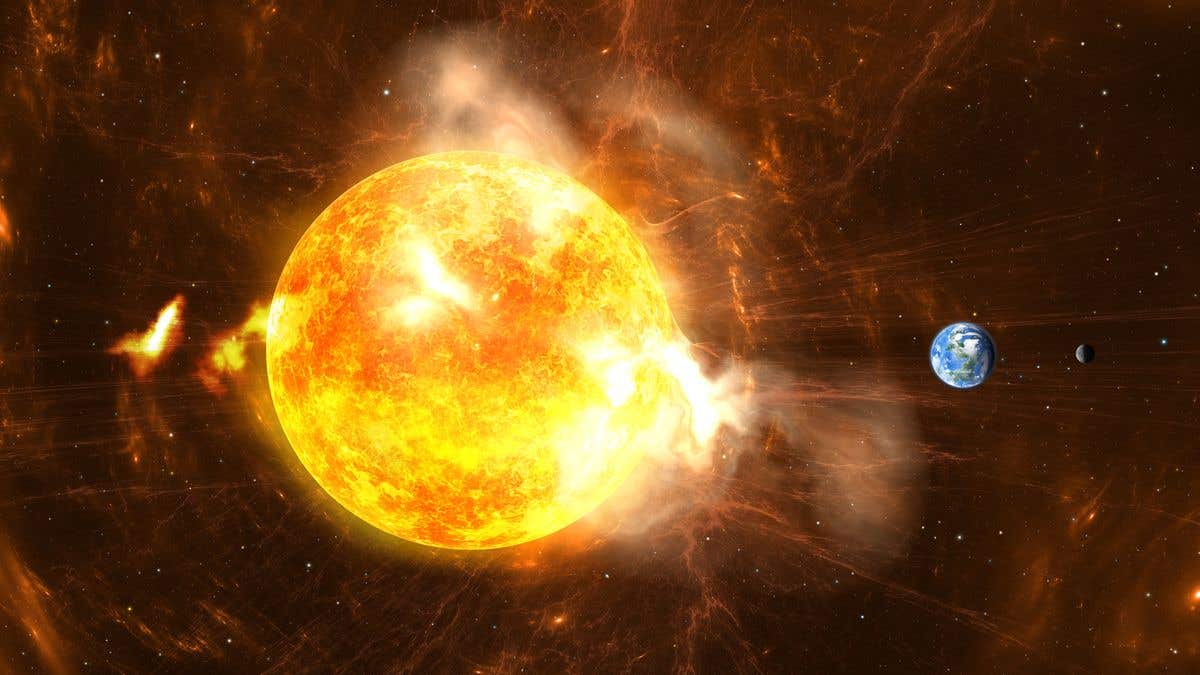New X-ray scans track violent solar winds threatening Earth’s satellites
A team in Japan has used soft X-ray imaging and supercomputer models to measure magnetic reconnection rates, a breakthrough in space weather forecasting.

Scientists use soft X-rays to measure magnetic reconnection, offering a new way to forecast space weather. (CREDIT: Getty Images)
High above Earth, where space and the planet’s magnetic field meet, powerful forces collide. Streams of charged particles known as the solar wind constantly flow from the Sun toward Earth. Most of the time, these particles are deflected by a protective magnetic bubble called the magnetosphere. This invisible shield keeps our atmosphere safe and protects satellites, GPS systems, and astronauts from dangerous solar radiation.
But the magnetosphere isn't invincible. Sometimes, solar wind particles break through in a sudden process called magnetic reconnection. This happens when magnetic field lines from different regions snap apart and then reconnect, releasing bursts of energy that ripple through space. These bursts can damage satellites and disrupt communications. As we become more dependent on space technology, scientists are racing to understand and predict these events more accurately.
A Fresh Look at an Old Challenge
For years, researchers have tried to measure the speed and strength of magnetic reconnection, known as the reconnection rate. This rate tells us how fast solar wind energy transfers into the magnetosphere. But finding a reliable way to measure it across large regions has been difficult. Traditional methods rely on spacecraft flying through small areas or using narrow views from solar telescopes. These techniques capture only brief, local snapshots.
Now, a team of researchers in Japan has proposed a new way to observe the reconnection rate. They use soft X-rays, a type of high-energy light invisible to the human eye, which appear during interactions between solar wind ions and neutral hydrogen atoms from Earth. This process, called solar wind charge exchange, or SWCX, produces a faint X-ray glow along the boundary of the magnetosphere.
Yosuke Matsumoto, an associate professor at Chiba University’s Institute for Advanced Academic Research, led the study. Collaborators included Ryota Momose, also from Chiba University, and Yoshizumi Miyoshi from Nagoya University. Their research appeared in Geophysical Research Letters.
Seeing Reconnection in X-rays
To explore this idea, the team used Japan’s powerful Fugaku supercomputer to run detailed simulations of the Earth’s magnetic field and the solar wind. They modeled how soft X-rays would appear during a coronal mass ejection—an intense solar event that floods space with high-speed particles. Their simulation focused on how these emissions would look from a position far from Earth, about the distance of the Moon.
Related Stories
- Is interstellar object 3I/ATLAS an alien probe? Harvard physicist sparks debate
- Protoplanetary mystery solved: A giant planet was there all along
- Betelgeuse’s hidden companion star, Siwarha, discovered after a century of mystery
This location matches the planned orbit of future satellites like GEO-X, an upcoming mission designed to observe Earth’s magnetic environment using X-ray cameras. From that vantage point, a satellite could watch the entire dayside of the magnetosphere—where reconnection events often occur—at once.
The simulation results were striking. The researchers found that X-ray emissions near the dayside boundary formed bright, V-shaped structures. These shapes mirrored the curved paths of reconnected magnetic field lines. By measuring the angle of these X-ray patterns, they calculated the global reconnection rate at 0.13. This value lines up well with both theoretical models and earlier experimental results.
“Imaging X-rays from the sun-facing magnetospheric boundary can now potentially quantify solar wind energy inflow into the magnetosphere, making X-rays a novel space weather diagnostic tool,” said Matsumoto.
Bridging the Gap Between Local and Global
In addition to measuring the angle of bright X-ray regions, the team also compared their results to another method: estimating the local reconnection electric field from the same magnetohydrodynamic (MHD) simulation. The agreement between these two approaches shows that soft X-rays can reflect not just where reconnection happens, but how fast it occurs across broad regions.
This ability to monitor global reconnection rates is new and exciting. Until now, there has been a gap between the small-scale data collected by spacecraft and the broader energy flows predicted by models. The new method helps close that gap by allowing researchers to see large-scale reconnection from afar, while still comparing it to more localized measurements.
Coordinated observations from space telescopes and in situ spacecraft could give scientists the best of both worlds. By combining both perspectives, future studies may better explain how magnetic reconnection shapes the space environment around Earth.
Why This Matters for Earth and Beyond
This discovery is more than just a scientific breakthrough—it has practical consequences. As human activity in space grows, so do the risks from space weather. Solar storms caused by reconnection can damage spacecraft electronics, affect astronauts' health, and even knock out power grids on Earth. Knowing when and where reconnection is likely to happen could help scientists issue warnings and protect vital systems.
Better forecasting tools are urgently needed. Satellites that can detect X-rays from Earth’s magnetic boundary could offer a new kind of early warning system. These satellites would work much like weather radars on Earth, scanning the sky for signs of danger. If reconnection rates rise, operators on the ground could take action to reduce harm.
But the importance of this research stretches even further. Magnetic reconnection isn't just a problem for Earth. It happens in stars, black holes, and fusion devices on Earth. In fact, it's one of the main hurdles scientists face in trying to create stable nuclear fusion—a process that could one day provide clean, limitless energy.
“Magnetic reconnection is not only responsible for breaching Earth’s magnetic shield but is also the underlying process behind explosive events in plasma devices, the Sun, and black holes,” said Matsumoto. “Understanding this process is essential for advancing technologies like plasma confinement in fusion reactors and investigating the origin of high-energy cosmic rays.”
Eyes on the Future
Looking ahead, the team hopes that future space missions will use soft X-ray imaging as a regular tool for watching the magnetosphere. If satellites like GEO-X can confirm the simulation results in real space conditions, it could mark a turning point in space weather forecasting.
This method could eventually become part of an international system for monitoring solar activity and protecting space infrastructure. As humans launch more satellites, build space stations, and prepare for lunar and Martian travel, having better ways to predict the impact of solar wind becomes a mission-critical priority.
Thanks to this research, the day may soon come when X-ray images not only reveal what lies inside the human body but also help protect the delicate boundary between Earth and space.
Note: The article above provided above by The Brighter Side of News.
Like these kind of feel good stories? Get The Brighter Side of News' newsletter.



